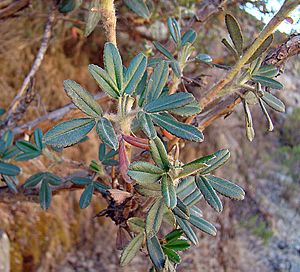Polylepis besseri facts for kids
Quick facts for kids Polylepis besseri |
|
|---|---|
 |
|
| Scientific classification | |
| Genus: |
Polylepis
|
| Species: |
besseri
|
Polylepis besseri is a special type of tree or shrub. It belongs to the Rosaceae family, which also includes roses and apple trees! This plant is native to two countries in South America: Bolivia and Peru.
Contents
What Are Polylepis Trees?
Polylepis trees are unique because they grow in very high places. They are often found in the Andes Mountains. These trees are known for their reddish, papery bark. The bark peels off in thin layers. This gives them a very distinct look.
Where Do They Live?
Polylepis besseri thrives in the high-altitude regions of Bolivia and Peru. They grow in areas that can be very cold and windy. These trees form forests that are often called "cloud forests" because they are so high up. They can be found at elevations of up to 5,000 meters (about 16,400 feet) above sea level. This makes them some of the highest-growing trees in the world!
What Do They Look Like?
Polylepis besseri trees are usually small to medium-sized. They can grow up to 10 meters (about 33 feet) tall. Their leaves are small and often have a fuzzy texture. This helps them survive in cold, dry conditions. The branches are often twisted and gnarled. This adds to their ancient and rugged appearance.
Why Are They Important?
Polylepis forests are very important for the environment. They help prevent soil erosion on steep mountain slopes. They also act like sponges, soaking up water from clouds and releasing it slowly. This helps provide water for rivers and streams. Many unique animals and plants also live in these forests. They depend on Polylepis trees for food and shelter.
Reproduction and Life Cycle
Polylepis besseri trees reproduce by making seeds. These seeds are often spread by wind or animals. The trees grow slowly, especially in harsh mountain environments. They can live for many years, becoming strong and resilient. Their ability to grow in such extreme conditions makes them very special.
Conservation Efforts
Sadly, many Polylepis forests are in danger. They have been cut down for firewood or to clear land for farming. This has made Polylepis besseri and other Polylepis species vulnerable. People are now working to protect these amazing trees. Efforts include planting new trees and educating local communities. Protecting these forests helps save unique wildlife and water sources.
See also
 In Spanish: Queñua para niños
In Spanish: Queñua para niños

